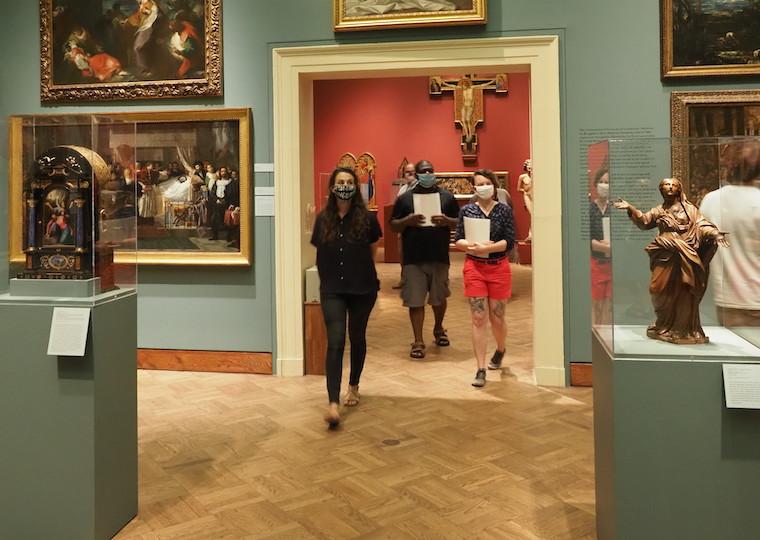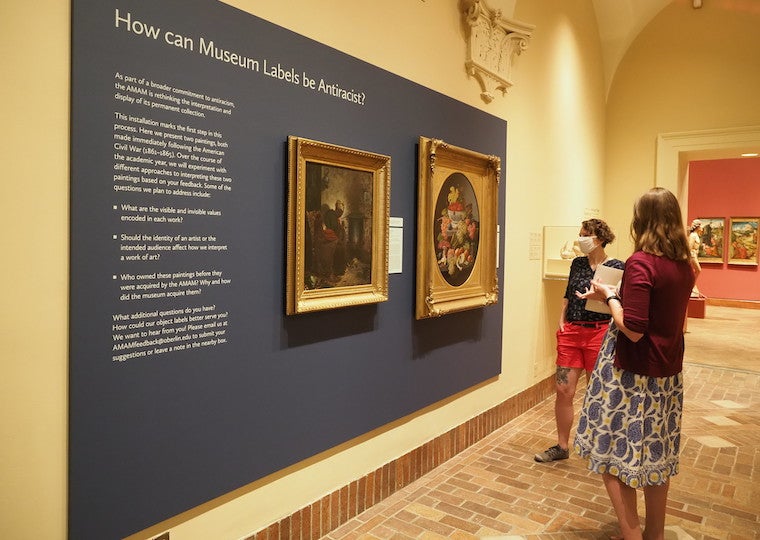The Allen Memorial Art Museum Reopens
September 1, 2020
Yvonne Gay

Faculty members explore the Willard-Newell Gallery in the Allen Memorial Art Museum.
Photo credit: Dale Preston ’83
After a welcome by John G. W. Cowles Director Andria Derstine and Assistant Curator of Academic Programs Hannah Kinney, a group of about seven new faculty members were given guided tours of the galleries by curators of the Allen Memorial Art Museum, including stops by new exhibits.
College faculty and staff who wish to visit the museum may do so by appointment now through September 4. The museum will hold regular hours—10 a.m. to 5 p.m.—from Tuesday to Friday starting on September 8. The galleries will be open to students, faculty, and staff who are holders of Oberlin College ID cards and participants in the college’s COVID-19 testing program. Masks and social distancing are required at all times.
Derstine and Kinney touch on some of the questions that visitors may have, from safety protocols to the use of the space for classes.
With the reopening of the museum, some people may be wondering what they can expect when they return to the space—what protocols are in place. Can you tell us some of these changes?
DERSTINE: At the AMAM, we have implemented a variety of new safety protocols. These include:
- Entrance only for students, faculty, and staff who are current holders of Oberlin College ID cards, and who are participating in the college’s COVID-19 testing program.
- Checking IDs and recording names upon entry, in case of contact-tracing needs.
- Copious signage throughout the museum regarding the requirement for masks and social distancing.
- Hand sanitizing stations throughout the museum, and spray/wipes to clean lockers and portable stools, if those are used.
- One-way stairs.
- Gallery capacity limits to enable visitors to maintain a 6-foot distance from others. These range from seven in our smallest space (each side of the Stern Gallery, and the Nord and Willard-Newell galleries) to 32 (which includes both the King Sculpture Court and the four sides of its surrounding ambulatory).
Visitors may wonder if they are still able to explore the space as they did before the pandemic. Can you speak to that?
DERSTINE: Although we have many new safety protocols in place, our hope is that visitors will be able to experience the close connection to works on view that they did before. All of the galleries will be open and visitors should feel free to explore and enjoy them as they did before. We simply ask visitors to remain masked at all times, and to be aware of their social distance from others, as well as our gallery capacity limits. Should the limit be reached, visitors should move to another gallery until others have moved on.

What new exhibits should visitors expect?
DERSTINE: The curators have organized several brand-new exhibitions for this fall, and we have also extended some exhibitions that were on view last March to enable more visitors to see them.
New exhibitions include Do It Again: Repetition as Artistic Strategy, 1945 to Now, which takes as subject repetition, in many different forms, in modern and contemporary art; and Topographies of Representation, which, in a year with a presidential election, the census, and the centenary of women’s suffrage, examines ways of looking at American representative democracy through works by four women artists.
Exhibitions that have been extended since the spring include Ukiyo-e Prints from the Mary Ainsworth Collection, which highlights more than 100 Japanese prints that were part of an important bequest from an Oberlin alumna of the Class of 1889; The Enchantment of the Everyday: East Asian Decorative Arts from the Permanent Collection, which showcases works in lacquer, jade, glass, ivory and other media; and Monkeys, Apes, and Mr. Freer, which presents three Japanese paintings that were among more than 100 Asian works donated to the AMAM in 1912 by important collector Charles Lang Freer. Additionally, the museum’s installation of African works, which was originally conceived by students in a 2016 art department seminar, has been modified, and includes several recent acquisitions.
Why do you think your space is important to visit, particularly during these times?
DERSTINE: The staff and I know from our own experiences, but also from comments by many visitors, that in addition to fostering education, relaxation, and enjoyment, art can provide comfort and solace in times of stress. For many people, getting out of normal routines and into a new space can promote creativity and a more positive outlook. Art is thought-provoking and can help create conversation and community, as well as illuminate—and perhaps provide new perspectives on—important current issues. Our hope is that members of the college community will want to visit the museum not only because of its importance to a broad range of courses in the curriculum, but also simply to take a break, get into a new environment, and perhaps learn something new.
I understand classes will have the opportunity to use the sace this year. How will they be able to use it?
KINNEY: Even though social distancing has required us to make some adjustments, this year the AMAM’s Office of Academic Programs is continuing to provide interactive learning experiences that prioritize close looking, critical analysis, and creative thinking for all Oberlin students. As in years past, we will collaborate with faculty members to design museum visits that respond directly to the needs of their course. We will offer in-person, remote, and hybrid visits. In all cases, direct engagement with the AMAM’s collection will be central. In the galleries, we will use worksheets and VoiceThread to guide independent and small-group looking. On Zoom, discussions will be focused on high-quality images explored in intimate detail through the presentation platform Prezi. In many cases, content and questions first encountered on digital platforms will be enhanced by viewing sessions in the museum’s galleries and Print Study Room. As we’ve adapted our teaching to the challenges we face this academic year, we’ve concentrated on taking advantage of each platform’s affordances and using them to enhance one another. Throughout the constant reconfiguring and rethinking, we have been guided by our dedication to introducing students to the unique opportunities provided by having a rich museum collection, such as the AMAM’s, on campus.
What do you enjoy about the museum?
DERSTINE: One of the things I enjoy most about the AMAM is that it is an encyclopedic museum—that means, it has art from virtually all of the world’s cultures. Our collection spans 6,000 years and six continents, and includes works in all media, from the ancient Near East to today. I also enjoy how connected we are with our audiences, even in this challenging time of COVID-19. I encourage everyone to visit us online, as our education department has devised a number of public programs that will roll out each month via videos or webinars. We want to stay connected with the college and local communities through art—even if we need to be a bit farther apart than usual.
You may also like…
Josh Nolan Named Vice President, General Counsel, and Secretary at Oberlin
Distinguished attorney brings extensive experience in higher education law.
Learning by Teaching: Oberlin Students Share Global Music with Young Learners
College and Conservatory students in PACE 103 prepare local children for an immersive community concert at Oberlin.
Nuiko Wadden ’02 Joins Oberlin Conservatory Faculty as Assistant Professor of Harp
The versatile musician brings extensive opera, orchestral, and contemporary music experience to her role


